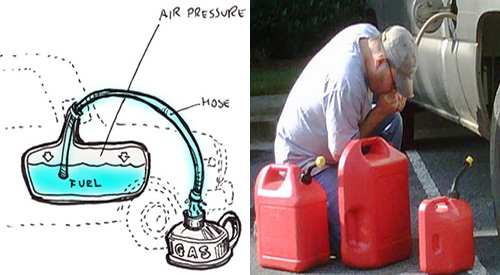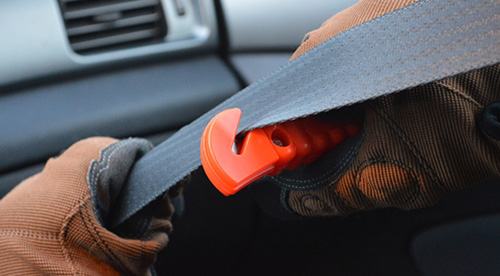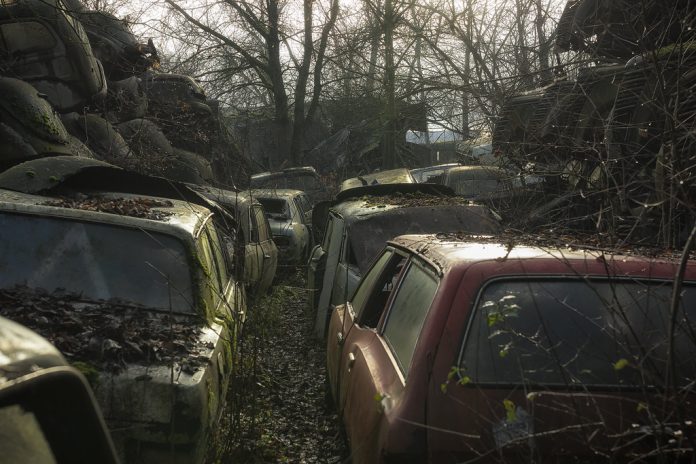No post-apocalyptic film without the stripped hulks of a few cars lying around is complete. They are the best scene dressing for a disaster, because they will be abandoned vehicles when society collapses. People run out of gas, have a mechanical failure or encounter a roadblock, so they ditch their car and leave. And, definitely, the cars will be stripped, because switched-on preppers won’t leave all that useful stuff around.
We take cars for granted, but they are complex machines that have a lot of material and technology. A standard modern vehicle is more than a lot of metal, plastic, and electrics – so even if it has been destroyed by an accident or an EMP, there’s plenty of stuff in it that you can save and use. Do not think “Junk” if the SHTF and you find an abandoned vehicle. It’s just a resources treasure cache.
Just for the sake of protection make sure a car is abandoned before you take out your pliers and start ripping off parts. If the owner has just pulled up and walked behind a bush to do his business, when he comes back he won’t be very happy and discovers you happily stripping his car down to a skeleton! However, once you are confident no one is coming back for it, continue scavenging. Here are some recommendations:
Related: 6 Emp-proof Cars That You Can Buy For Less Than $2000
1. Cabin clutter
Check the glove box, door pockets, console and below the seats. People keep all kinds of items in their cars, and they could leave some useful stuff behind if they leave the vehicle in a rush. Flashlights, maps – which are really useful when GPS is down – and food are all likely commodities.
Always look through the trunk. Many people still keep emergency equipment in their vehicle, so they might have left the equipment behind, depending on why they abandoned it. Others may have sought to avoid whatever tragedy occurred before they left, and loaded the car with belongings. Trunks are a possible source of spare clothes , food, blankets, and even camping equipment.
2. Tools
There are several cars equipped with tool-kits, so search the trunk. Pliers, wrenches and screwdrivers are also good to have. Also, if you already have equipments, there is no harm in picking up any spares. For starters, here’s a list of skills and tools you’ll need when SHTF is in.
3. Fuel
A lot of the vehicles you see will be abandoned in a catastrophic situation because they run out of gasoline-but some will still have plenty in the tank. You can get the filler caps off with a length of hose and a pry bar and siphon the remaining fuel out into a container. Only feed one end of the hose into the tank, suck on the other end until the fuel almost reaches your mouth – that’s almost important – then quickly lower that end until it’s below the other and let the fuel flow out into your canister. And if you do have a fuel supply for your own car and turbine, it won’t hurt a bit more.


Never try to empty a gas tank by poking a hole inside it. Real gas tanks aren’t as explosive as the Hollywood kind, but there’s still a chance that a spark will set the vapor in. If you are in the vicinity when that happens it will ruin your day.
Related: Types of Fuel for SHTF
4. Fluids
When you have a survival kit you can have some crystals of potassium permanganate in it. It has many advantages for water purification and as a disinfectant, so if you can remove any antifreeze from a car you can use it to start a fire as well. Mix the two 50:50 and then it will ignite in a few seconds.
Gas, brake fluid, and screen wash can also be removed from cars and used to replace your own. Screen wash is also a useful disinfectant-it is a mixture of water and alcohol.
5. Battery
Whether you have solar panels or a wind turbine at home, and you know some simple electrics, you can use a rig of car batteries to store and use excess electricity when it’s dark or the wind isn’t blowing. The more batteries you can carry, the more power you can produce; never miss the chance to gather another one and plug it into your device.
6. Wiring
Copper wire has many applications, and automobiles include yards of it. Working for an hour with some simple tools can get you a set of cables in different sizes. This can be used, or cut, for electrical projects to get to the wire. Copper wire is an ideal tool for creating snares.
Related: An Emergency Power Source? Your Car Battery
7. Hub caps
Many snow vehicles have alloy wheels, and those with hub caps often have plastic wheels, but if you find some old-fashioned metal hub caps, they can be useful – scrub one, for example, and use it as an improvised skillet.
8. Mirrors
A mirror is a good way to send signals of distress but the steel ones found in the kits of survival are not great. A salvaged rearview mirror will do a much better job. Wing mirrors are difficult to get off the car but a knife can pry out the actual mirror.
9. Upholstery
A car incorporates a lot of fabric, some of it really hard to wear. If you’re sleeping rough, seat coverings should make a decent ground sheet waterproof to keep the moisture away from you. The headliner is going to make a light blanket-not that warm, but much better than none.
10. Seat belts
Need straps? Seatbelt lengths are extremely solid. Then break them off at the loop, bring them out to full length. Seatbelt lengths make suitable belts for an improvised rucksack, or to tie loads on a wagon or sled. You get an efficient stretcher with several lengths fastened between two poles. If you need more length and less strength, you can cut the belts lengthwise into narrower lines, but check every so often to make sure they don’t start to tear. When you have the time to undo the fabric to get strong fibers that work for fishing lines, sewing thread or – after boiling – sutures.


11. Bodywork
When you are able to move big pieces of steel around, you can find uses for them. Doors, trunk lids, and hoods may be used to construct lean-to or animal enclosures. For a small shed, a hood will create a strong, weatherproof roof.
12. Spare parts
Last but not least, and most importantly, look for abandoned cars the same make and model as your own – and strip off all you can when you find one. This also involves the motor so you can tow it anywhere, or get a truck and chain-fall at it. The more pieces that you have, the lower the risk that a failure will terminally immobilize your own car.
Search even for the generic pieces. Air and oil filters, wiper blades, bulbs and fuses-anything that can be scrounged and fit yours.
Abandoned cars can be a nuisance. They block roads, normally clutter up the spot and may even be a fire hazard. But, they are also a valuable resource. You should never walk past an abandoned car in an emergency situation without looking for something useful, and in the long term you should find any hulk within the range of your home and strip it clean. The materials you recover may never be needed, but who knows? If you need a dozen hubcaps in a rush, picking them from a stack in your yard is easier than trying to recall where you’ve seen them.





















